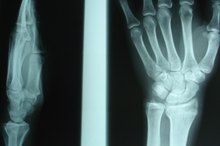What are the Symptoms of Blood Clots in the Wrist?
The wrist is an area much like the shoulder, where a variety of movement is necessary in normal use. Rotation of the joint as well as lateral movement can cause an extra amount of stress not only to the muscles and tendons that make up the structure of the joint, but also to the nerves and blood vessels that serve the structure. Damage to the wrist area from repetitious movement, trauma or even infection and old age may contribute to extensive pressure on the blood vessels, sometimes leading to thrombosis (blood clotting).
If you are experiencing serious medical symptoms, seek emergency treatment immediately.
Causes
The arteries that service the wrist can endure significant stress over time, especially when repeated motion exerts pressure in the area. Constriction of blood flow over time may cause damage to these arteries, causing the blood flow to be curtailed enough to result in blockage, which may result in clotting. This is generally considered to be rare by some medical professionals, yet the occurrence of blood clots in the wrist may necessitate the use of MRI or ultrasound examination to identify the problem.
Other Causes
What Are the Causes of Pain on Outer Side of Wrist?
Learn More
According to The Hand University, the ulnar and median nerves that service the wrist and hand structure pass through what is known as Guyon’s canal 1. This canal is a tube-like tunnel that runs through the wrist, through which the nerves as well as the arteries enter the wrist area. Damage from repeated movement, known as Guyon’s canal syndrome, or from trauma to the area can contribute to clotting in the blood as it passes through. While this is also considered to be a rare condition, it may nonetheless occur.
- According to The Hand University, the ulnar and median nerves that service the wrist and hand structure pass through what is known as Guyon’s canal 1.
- Damage from repeated movement, known as Guyon’s canal syndrome, or from trauma to the area can contribute to clotting in the blood as it passes through.
Symptoms
The symptoms of blood clots in the wrist can be similar to symptoms of nerve damage in this area. Generally speaking, a feeling of numbness or tingling may be felt in the wrist or possibly in the hand and fingers. According to the Colorado Hand and Arm P.C., these sensations may also be accompanied by pain or stiffness in the area of the wrist and the hand. The effect is the same on both the nerves and the arteries that service these areas, in that a trauma or other force has caused a stoppage of flow either of nerve signals or, in the case of arteries, of blood.
- The symptoms of blood clots in the wrist can be similar to symptoms of nerve damage in this area.
- According to the Colorado Hand and Arm P.C., these sensations may also be accompanied by pain or stiffness in the area of the wrist and the hand.
Other Symptoms
What Can Cause Blood Vessel Gurgling in the Legs?
Learn More
Swelling and discoloration can also be signs of blood clotting. This may not be easily diagnosed as thrombosis, due to the tendency of extremities, such as the arm, to swell naturally from either resting in its natural status (hanging by the side of the body) or from collection of blood in the wrist and hand area when sleeping. Discoloration will likely be in the form of bruising in the wrist area. This will be a more positive indication of a possible blood clot problem, especially in cases where no reported force trauma or injury has occurred.
- Swelling and discoloration can also be signs of blood clotting.
- This may not be easily diagnosed as thrombosis, due to the tendency of extremities, such as the arm, to swell naturally from either resting in its natural status (hanging by the side of the body) or from collection of blood in the wrist and hand area when sleeping.
Conclusions
The range of possibilities for development of blood clots in the wrist area may necessarily suggest a thorough examination by a doctor or other medical professional who is experienced in thrombosis diagnostics when related symptoms occur. While occurrences of blood clotting in the wrist are infrequent, the condition can and will develop in some cases.
Related Articles
References
- The Hand University
- Bass E. Tendinopathy: why the difference between tendinitis and tendinosis matters. Int J Ther Massage Bodywork. 2012;5(1):14-7.
- How can tenosynovitis be treated? Institute for Quality and Efficiency in Health Care (IQWiG). 2018.
- Chatterjee R, Vyas J. Diagnosis and management of intersection syndrome as a cause of overuse wrist pain. BMJ Case Rep. 2016;2016. doi:10.1136/bcr-2016-216988
- Wrist Sprain. What is it? Harvard Health Publishing. Harvard Medical School. 2019.
- Satteson E, Tannan S. De Quervain-Tenosynovitis. StatPearls Publishing. 2019.
- Carpal Tunnel Syndrome: Treating Hand Pain and Numbness. J Orthop Sports Phys Ther. 2019;49(5):361. doi:10.2519/jospt.2019.0502
- Hackney LA, Dodds SD. Assessment of scaphoid fracture healing. Curr Rev Musculoskelet Med. 2011;4(1):16-22. doi:10.1007/s12178-011-9072-0
- Lu H, Chen Q, Shen H. A repeated carpal tunnel syndrome due to tophaceous gout in flexor tendon: A case report. Medicine (Baltimore). 2017;96(9):e6245. doi:10.1097/MD.0000000000006245
- Jennings JD, Zielinski E, Tosti R, Ilyas AM. Septic Arthritis of the Wrist: Incidence, Risk Factors, and Predictors of Infection. Orthopedics. 2017;40(3):e526-e531. doi:10.3928/01477447-20170404-01
- Gregush R, Habusta S. Ganglion Cyst. StatPearls Publishing. 2019.
- Cutts S. Cubital tunnel syndrome. Postgrad Med J. 2007;83(975):28-31. doi:10.1136/pgmj.2006.047456
- Akhondi H, Panginikkod S. Wrist Arthritis. StatPearls Publishing. 2019.
- Caridi JM, Pumberger M, Hughes AP. Cervical radiculopathy: a review. HSS J. 2011;7(3):265-72. doi:10.1007/s11420-011-9218-z
- Paavola M, Kannus P, Järvinen TA, Järvinen TL, Józsa L, Järvinen M. Treatment of tendon disorders. Is there a role for corticosteroid injection?. Foot Ankle Clin. 2002;7(3):501-13.
- Adams JE, Habbu R. Tendinopathies of the Hand and Wrist. J Am Acad Orthop Surg. 2015 Dec;23(12):741-50.
- Dale AM, Harris-Adamson D, Rempel D, e al. Prevalence and incidence of carpal tunnel syndrome in US working populations: pooled analysis of six prospective studies. Scand J Work, Environ & Health. 2013;39(5):495-505. DOI: 10.5271/sjweh.3351.
- Goldfarb CA, Puri SK, Carlson MG. Diagnosis, Treatment, and Return to Play for Four Common Sports Injuries of the Hand and Wrist. J Am Acad Orthop Surg. 2016 Dec;24(12):853-862.
- Shehab R, Mirabelli MH. Evaluation and Diagnosis of Wrist Pain: A Case-Based Approach. Am Fam Physician. 2013 Apr 15;87(8):568-73.




